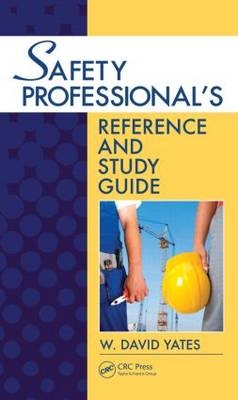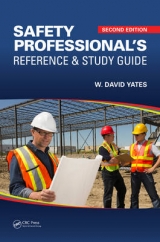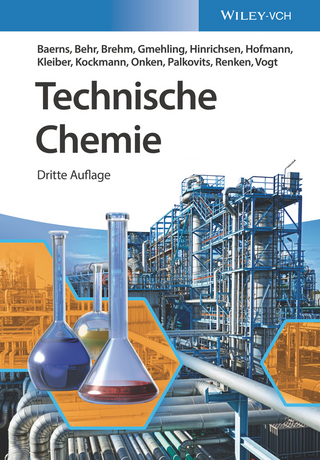
Safety Professional's Reference and Study Guide
Crc Press Inc (Verlag)
978-1-4398-3485-5 (ISBN)
- Titel erscheint in neuer Auflage
- Artikel merken
A "quick desk reference" for the experienced, practicing safety professional in comprehensive or specialized practice
A useful resource to supplement more in-depth textbooks for students
A primary study resource for those individuals preparing to take the Associate Safety Professional (ASP), Certified Safety Professional (CSP), Occupational Health and Safety Technologist (OHST), and the Construction Health and Safety Technologist (CHST) examination
The book covers topics such as math review, ventilation, noise, gases and particulates, radiation, toxicology, industrial hygiene, biological hazards, thermal stressors, statistics, fire protection and prevention, accident investigation, mechanics, hydrostatics and hydraulics, electrical safety, engineering economy, and workers compensation. It provides step-by-step instructions on how to solve the equations and formulas on the exam and gives examples on how and when to use them.
With roots that extend as far back as 1700 B.C., the safety profession has evolved over the centuries. Passage of legislation has highlighted the need for educated and knowledgeable professionals and changes in science and technology requires them to have a broad range of knowledge in areas such as biology, chemistry, mathematics, and chemistry. This book consolidates practical information and puts it within easy reach, saving you the time and trouble of searching through a myriad of resources to find what you need.
W. David Yates was born in Morton, Mississippi, and lived most of his childhood in Crystal Springs, Mississippi. He earned a BS in Health Care Services from Southern Illinois University, Carbondale, Illinois; an MS in Hazardous Materials Management from Jackson State University, Jackson, Mississippi; and a PhD in Environmental Science from Jackson State University, Jackson, Mississippi. Dr. Yates served for 10 years in the United States Navy as a preventive medicine technician. Dr. Yates currently serves in the Army National Guard as a safety and occupational health officer. In his civilian career, Dr. Yates has had his own professional consulting firm, has served as the safety and mission assurance manager for Stennis Space Center, Mississippi, and is currently serving as the corporate safety director for Bodine Services of the Midwest, Decatur, Illinois. He is a certified safety professional (CSP) with the Board of Certified Safety Professionals. Dr. Yates has extensive knowledge and experience in hazardous material management, safety programs management, indoor air quality, ventilation, noise and sound, and industrial hygiene sampling and analysis. Dr. Yates’ e-mail address is dyates@bodineservices.com. Bodine Services of the Midwest home page is http://www.bodineservices.com.
The Safety Profession and Preparing for the ASP/CSP Examination
Board of Certified Safety Professionals (BCSP)
Definitions
Professional Safety Experience Requirements
Associate Safety Professional Process
Certified Safety Professional Process
Safety Fundamentals Examination Blueprint
Comprehensive Practice Examination Blueprint
Preparing for the ASP/CSP Examinations
Knowing Your Strengths and Weaknesses
Developing an Examination Preparation Plan
References and Resources
Test Taking Strategy
Registering For and Taking the ASP/CSP Examinations
Locating a Pearson VUE Test Center
Purchasing an Examination Authorization
Receiving Your Examination Authorization Letter
Scheduling an Examination Appointment
Taking the Examination
Late Arrivals and Missed Appointments
Canceling and Rescheduling Examination Appointments
Retesting
Other Testing Arrangements
Reference
Regulations and OSHA Record Keeping
Occupational Safety and Health Act
Horizontal and Vertical Standards
General Duty Clause
Employer Rights and Responsibilities
Employee Rights and Responsibilities
Communications and Correspondence with OSHA
OSHA Inspections and Process
OSHA Citations
OSHA Citation Penalties
Appeals
Petition for Modification of Abatement
Notice of Contest
Review Procedure
Hazard Communication Standard (29 CFR 1910.1200)
Written Hazardous Communication Program
Label and Other Forms of Warning
Material Safety Data Sheets
Employee Information and Training
Bloodborne Pathogen Standard (29 CFR 1910.1030)
Record Keeping
Control of Hazardous Energy Standard (29 CFR 1910.147)
Energy Control Program
Periodic Inspection
Training and Communication
Confined Space Entry Standard (29 CFR 1910.146)
General Requirements
Confined Space Entry Program
Entry Permits
Training
Personal Protective Equipment (29 CFR 1910.132)
Employee-Owned Equipment
Hazard Assessment and Equipment Selection
Training
Respiratory Protection Standard (29 CFR 1910.134)
Training and Information
Fall Protection Standard (29 CFR 1926.500–503) (Subpart M)
Duty to Have Fall Protection
Training
Record Keeping
Calculating Total Case Incident Rates (TCIR)
Calculating Days Away, Restricted, or Transfer Rates
Calculating Severity Rates
Key Information to Remember on Regulations
References
Math Review
Order of Operations
PEMDAS: “Please Excuse My Dear Aunt Sally”
Basic Rules of Positive and Negative Numbers
Understanding Exponents
Scientific Notation
Multiplication and Division Using Scientific Notation
Engineering Notation
Absolute Values
Logarithms
Formula or Equation Transpositions
Factorials
Common Geometric Equations
Pythagorean Equation
Basic Trigonometric Functions
ArcSine, ArcCosine, and ArcTangent
Quadratic Equation
Calculator
Summary
Particulates and Gases
Periodic Table of the Elements
Chemical Bonding
Gas Laws
Referenced Equations
Calculating PELs/TLVs for Periods Greater than 8 h
Key Information to Remember on Particulates and Gases
References
Toxicology
Definitions
Routes of Entry
Dose-Response Relationship
Exposures to Chemical Combinations
Stages of Cancer
Types of Poisons
Ames Testing
Cohort Study
Case Control Study
Cross-Sectional Study
Key Information to Remember on Toxicology
References
Industrial Hygiene
Anticipation of Hazards
Recognition of Hazards
Evaluation of Hazards
Control of Hazards
Definitions
Air Sampling
References
Ventilation
Purpose for Using Ventilation
Types and Selection of Ventilation
Principles of Air Movement
Contaminant Generation
Calculating Purge Rates
Steady State Concentration
Calculating Rate of Generation for Liquid Solvents
Calculating Vapor or Gaseous Concentrations
Calculating Room Air Changes
Local Exhaust Ventilation
Calculating Hood Entry Losses
Calculating Air Flow Velocity
Calculating Capture Velocity for Plain Opening Hood
Ducts
Fans
Air Cleaning Devices
Ventilation Measurement Equipment
Key Information to Remember on Ventilation
Reference
Noise and OSHA’s Hearing Conservation Program
OSHA’s Hearing Conservation Program
Noise-related Definitions
Anatomy and Physiology of the Ear
Types of Hearing Loss
OSHA Permissible Noise Exposures
Entities of Noise
Noise Calculations
Key Information to Remember on Noise
References
Biological Hazards
Bacterial Diseases
Viral Diseases
Rickettsial and Chlamydia Diseases
Fungal Diseases
Biological Safety
Biosafety Levels
Key Information to Remember on Biological Hazards
References
Fire Protection and Prevention
Definitions
Transfer of Heat
Fire Tetrahedron
Classification of Fires
Portable Fire Extinguishers
Automatic Sprinkler Systems
Fire Hydrants
Fire Detection
Fire Hydrants
Flammable and Combustible Liquids
Works Cited
Thermal Stressors
Heat Stress
Control Methods
Prevention of Heat Stress Injuries
Cold Stress
Cold-Related Injuries and IllnessesKey Information to Remember on Thermal Stressors
References
Personal Protective Equipment
Hazard Assessment
Head Protection (29 CFR 1910.135)
Eye and Face Protection (29 CFR 1910.133)
Hearing Protection (29 CFR 1910.95)
Respiratory Protection (29 CFR 1910.134)
Purpose
Definitions
Respiratory Protection Program
Torso Protection
Arm and Hand Protection (29 CFR 1910.138)
Glove Selection Chart
Foot and Leg Protection (29 CFR 1910.136)
References
Statistics for the Safety Professional
Descriptive Statistics
Mean
Mode
Median
Variance
Distribution
Calculating Correlation Coefficient
Spearman Rank Coef- cient of Correlation
Calculating the t-Test for Comparing Means
Chi-Square (χ2) Statistic
Permutations and Combinations
Z-Score
Coefficient of Determination and Coef- cient of Correlation
Probability Content from −00 to Z
Reliability
System Reliability
References
Electrical Safety
Electricity Basics
Resistors
Capacitors
Inductors
Electrical Shock Hazard
Burns Caused by Electricity
Electrical Fires
Controlling Electrical Hazards
Key Information to Remember on Electrical Safety
References
Mechanics
Energy
Kinetic Energy
Potential Energy
Elastic Potential Energy
Force
Defining Mass and Weight
Amount of Force
Frictional Force
Force and Distance
Momentum
Work
Newton’s Laws of Motion
Calculating Final Velocity
Calculating Displacement
Key Information to Remember on Mechanics
Reference
Hydrostatics and Hydraulics
Water Properties
Hydrostatic Pressure
Torricelli’s Law
Head Pressure
Velocity Head
Velocity Pressure at Constant Laminar Velocity
Flow Rates and Pressure Drops
Flow Rates and Pressures
Calculating Pressure Loss Due To Friction
Bernoulli’s Principle
Key Information to Remember on Hydrostatics and Hydraulics
References
Training
Principles of Adult Learning
Safety Training Program
Delivery Methods
Training Needs Analysis
Training Program Development
Media Presentations
Key Information to Remember on Training
References
Engineering Economics
Simple Interest
Compound Interest
Future Value of Money
Loan Balance
Time Value of Money
Series Compound Amount Factor
Sinking Fund Factor
Capital Recovery Factor
Series Present Worth Factor
Summary
Reference
Management Theories
Management Theories
McGregor’s Theory X and Theory Y
Herzberg Motivational Theory
The Deming Cycle
Management by Objectives
Contingency Theory
Systems Theory
Chaos Theory
Management Styles
Key Information to Remember on Management Theories
References
Accident Causation and Investigation Techniques
Domino Theory
Human Factors Theory
Accident/Incident Theory
Epidemiological Theory
Systems Theory
Energy Release Theory
Behavior Theory
Combination Theory
Modern Causation Model
Near-Miss Relationship
Accident Investigation Procedures
Fact Finding
Interviews
Fault Tree Analysis
Multilinear Events Sequencing Method
Report of Investigation
References
Worker’s Compensation
History of Worker’s Compensation in the United States
Current Worker’s Compensation Laws
Coverage Exemptions
Worker’s Compensation Premiums
Key Information to Remember on Worker’s Compensation
Reference
Ergonomics
Definitions
NIOSH Lifting Equation
Horizontal Component
Vertical Component
Distance Component
Asymmetry Component
Frequency Component
Coupling Component
Lifting Index
Job Analysis Worksheet
Example Problems
Key Information to Remember on Ergonomics
References
Construction Safety
Excavation
Electrical Safety in Construction
Scaffolds
Fall Protection and Prevention in Construction
Cranes and Derrick Safety (29 CFR 1926.550)
Welding, Cutting, and Brazing (29 CFR 1926.350–353)
Hand and Power Tool Safety (29 CFR 1910 Subpart P)
Housekeeping (29 CFR 1926.25)
Key Information to Remember on Construction Safety
References
Risk Management
Definitions
Risk Management Process
Key Information to Remember on Risk Management
References
Hazardous Materials Management
Hazardous Materials
Hazardous Waste
Basic Chemistry Review
Defi nitions Related to Matter
Periodic Table of the Elements
Measurements of Concentrations
Hazardous Materials/Hazardous Waste Properties
Physical Hazards
Health Hazards Associated with Hazardous Materials
Classification of Hazardous Materials
Hazardous Waste Operations
References
Radiation Safety
Ionizing Radiation
Particle Radiation
Electromagnetic Radiation
Radiation Basics
Biological Effects of Ionizing Radiation
Description of Ionizing Radiation Units
Types of Radioactive Decay
Radioactive Half-Life
Radiation Control Methods
Personal Protective Equipment
OSHA Exposure Standards
Nonionizing Radiation
Appendix A: BCSP Supplied Equations
Appendix B: OSHA Regional and Area Offices
Appendix C: Conversions and Standards
Index
| Erscheint lt. Verlag | 31.1.2011 |
|---|---|
| Zusatzinfo | 389 equations; 57 Tables, black and white; 51 Illustrations, black and white |
| Verlagsort | Bosa Roca |
| Sprache | englisch |
| Maße | 156 x 234 mm |
| Gewicht | 953 g |
| Themenwelt | Naturwissenschaften ► Chemie ► Technische Chemie |
| Technik ► Umwelttechnik / Biotechnologie | |
| Wirtschaft | |
| ISBN-10 | 1-4398-3485-7 / 1439834857 |
| ISBN-13 | 978-1-4398-3485-5 / 9781439834855 |
| Zustand | Neuware |
| Informationen gemäß Produktsicherheitsverordnung (GPSR) | |
| Haben Sie eine Frage zum Produkt? |
aus dem Bereich



